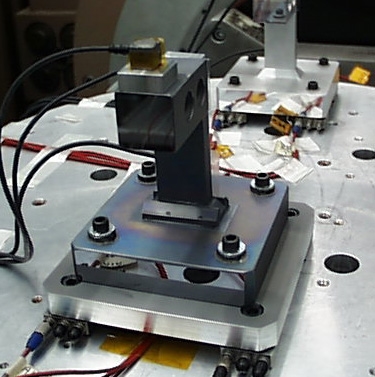
Glass Frit Bonding
Our proprietary Glass Frit Bonding method has proven to be the most reliable and optically stable method for producing lightweight, large scale, and complex Single Crystal Si structures and optics.
Why frit?
Glass Frit is a mixture of different elements melted, shattered, and ground into a powder and has been used as a bonding agent in electronic, electrical, and other applications for many years. Frit provides a number of advantages over other bonding techniques. Electrical insulation and hermeticity are major advantages, as well as high viscosity and low flow which allow good control of the bondline. Glass frit has low reactivity and no eutectics are formed. The homogeneous nature of most glasses is synonymous with temperal and thermal stability. And, there is the possibility of repair by refiring, disassembly o,f and reuse by means of high temperature or chemical means. In our intenal R&D, we have shown that the glass frit bonding joint can withstand extreme temperature changes, extreme vibration excitement, and radiation hardening.
Our frit bonding process has a five-year plus optical stability performance record. In September of 2006, Dr. Dave Content, with NASA Goddard Space Flight Center, measured a McCarter lightweighted (19 kgm2) SCSi 6.7" diameter mirror with a 6 to 1 aspect ratio and a 600mm aperture radius that he bought from us in 2001. The results of the mirror measurements in 2001 showed P/V .410wv RMS .068 and in 2006, the measurement showed P/V .420wv RMS .070, which demonstrates that the mirror had no notable movement since 2001.
Frit allows for scalability in weight
McCarter Frit Bonded Lightweight Mirror
McCarter Frit Bonded Lightweight Mirror
McCarter Mirror Weight Classifications
Having a variety of weight categories for optical mirrors and structures gives the customer flexibility when designing for payload requirements. We have manufactured mirrors in each of the four weight categories. Previously, the amount of print-through created during the polishing process restricted the design of the web support used in lightweight mirrors. QED Corporation was able to remove 100% of the print-through in
90 minutes on a Simplistic Lightweight Mirror using their patented MRF process. The ability to remove the print-through demonstrates a breakthrough that not only expands the limits on lightweighting but also lowers the time of production.
Frit allows for scalability in size and complexity
One customer needed a Single Crystal Si assembly that was 17" in diameter consisting of 7 parts, each one made using Single Crystal Si. Below are pictures of the progession of manufacturing one of those parts, with the last picture showing the assembled component. As shown, this part required cooling passages, core drilled holes and slots, and a hyperbolic contour. There were no failures across the bondlines and all of the cores remained intact. Effectively, the bonded planks machined as if it was monolithic.
This complex Single Crystal Si test component is a seven-piece cantilevered assembly with two mirror surfaces finished directly on the structure with 4 frit bonded inserts for mounting. In this picture you see our Single Crystal Si structure along side a monolithic aluminum structure. Both underwent flight simulated vibration testing. The results demonstrated the dynamic stability of not only the Single Crystal Si material, but also of our frit bonding and metal insert technology. Read about the results here.
On the test bed at Goddard Space Flight Center
Frit adds Dampening
In order to test the structural stability of the frit bonded silicon structure shown above, a relative measurement was made between the two optical surfaces of the test article both before and after being subjected to a high level random vibration environment. The results show a change of only 0.1 arcsecond in both the horizontal and vertical directions from the pre and post test measurements. This shows excellent structural stability for the level of random vibration for which the test item was subjected (it should be noted that 0.1 arcsecond is in the noise floor of the measurement).
Single Crystal Si is one of the only candidates that survives and remains stable during rapid thermal changes and throughout all four modes of launch excitement.













